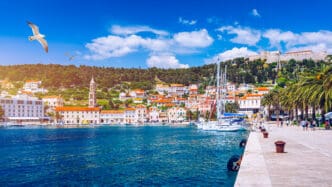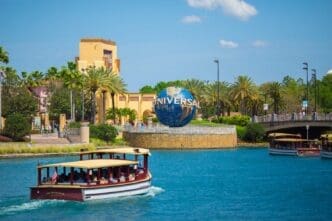Your Essential Overview
- Split, Dubrovnik, and Zadar are identified as the three major gateway cities for first-time visitors to Croatia’s Dalmatian Coast.
- Each city offers distinct advantages: Split provides a central, versatile base for exploration, Dubrovnik offers unparalleled historical grandeur, and Zadar blends Roman roots with modern art in a more relaxed setting.
- For most first-time visitors, Split is recommended as the most practical and balanced starting point due to its central location, excellent transport links, and diverse day-trip opportunities to islands and national parks.
The Destination’s Lore
- The Dalmatian Coast is a historically rich and naturally diverse region of Croatia, characterized by a blend of ancient Roman, Venetian, and Austro-Hungarian influences, dramatic landscapes, and thousands of islands. This extensive variety creates a wide array of attractions but also makes the initial choice of a starting point crucial for first-time visitors, as it significantly shapes their entire travel experience.
Making the Trip Yours
- For first-time visitors to Croatia’s Dalmatian Coast, the initial choice of a starting city—Split, Dubrovnik, or Zadar—is crucial, as it fundamentally dictates the rhythm, focus, and overall experience of their trip. Split is presented as the most versatile gateway, offering a balanced mix of history, island hopping, and nature, making it ideal for a comprehensive introduction. In contrast, Dubrovnik caters to those prioritizing historical grandeur but comes with potential drawbacks like crowds and higher costs, while Zadar provides a more relaxed, budget-friendly option with unique modern attractions and access to northern national parks.
Perspectives from the Road
- Many first-time visitors will find Split to be the most practical and culturally rich starting point, offering a central location, excellent transport links, and a balanced mix of history, island hopping, and national park access.
- Those primarily interested in experiencing a living medieval city with unparalleled historical grandeur should choose Dubrovnik, despite its popularity and less central location.
- Travelers seeking a slightly more relaxed introduction with a unique blend of Roman heritage, modern art installations, and proximity to national parks, often with fewer crowds, will find Zadar to be an ideal starting point.
For many intrepid travelers, Croatia’s sun-drenched Dalmatian Coast represents the quintessential Mediterranean escape, a breathtaking stretch of Adriatic shoreline dotted with ancient cities, charming islands, and azure waters. Deciding where to begin your journey along this iconic coast can feel overwhelming, as each destination offers a unique blend of history, culture, and natural beauty. For first-time visitors, the strategic starting point often dictates the rhythm and focus of their entire Croatian adventure, making the initial choice crucial for an unforgettable experience.

Understanding the Dalmatian Coast
The Dalmatian Coast is a region of Croatia stretching from the island of Rab in the north to the Bay of Kotor in the south, though the Croatian part typically ends near Dubrovnik. It is characterized by its dramatic limestone cliffs, thousands of islands and islets, and a rich history shaped by Roman, Venetian, and Austro-Hungarian empires. This blend results in a stunning landscape intertwined with millennia of human civilization, offering everything from bustling port cities to tranquil island retreats.
Its appeal lies in its diverse offerings: ancient ruins stand beside vibrant modern life, pristine national parks border lively beaches, and a culinary scene thrives on fresh seafood and local wines. The coast is a paradise for sailors, history buffs, foodies, and those simply seeking sun and relaxation. Understanding this rich tapestry is the first step in pinpointing your ideal entry point.

The “Big Three” Starting Points for First-Timers
When considering where to go first, three major cities stand out as primary gateways to the Dalmatian Coast: Split, Dubrovnik, and Zadar. Each offers distinct advantages in terms of accessibility, attractions, and onward travel opportunities.
Split: The Imperial Gateway
Split is arguably the most practical and culturally rich starting point for many first-time visitors to the Dalmatian Coast. Its central location, excellent transport links, and the UNESCO-listed Diocletian’s Palace make it an ideal base for exploration. The city itself is a living museum, with the ancient Roman palace forming its vibrant heart.
Within Split, wander through the narrow streets of Diocletian’s Palace, where ancient walls now house shops, cafes, and apartments. Stroll along the Riva promenade, a bustling waterfront perfect for people-watching, or climb Marjan Hill for panoramic views of the city and surrounding islands. The city’s energy is infectious, blending historical reverence with modern Croatian life.
From Split, day trips are incredibly convenient and diverse. You can easily catch a ferry to popular islands like Hvar, known for its glamorous nightlife and lavender fields, or Brač, home to the iconic Zlatni Rat beach. The historic town of Trogir, another UNESCO World Heritage site, is just a short bus ride away, offering a charming medieval experience. Furthermore, the stunning waterfalls of Krka National Park are within easy reach by bus or organized tour, providing a refreshing natural escape.
Dubrovnik: The Pearl of the Adriatic
Dubrovnik, often dubbed the “Pearl of the Adriatic,” is undoubtedly the most famous destination on the Dalmatian Coast, largely thanks to its impeccably preserved Old Town and impressive city walls. For those whose primary interest is experiencing a living medieval city with unparalleled historical grandeur, Dubrovnik is an excellent, albeit often crowded, choice.
Walking the ancient city walls, which offer breathtaking views of the terracotta rooftops and the shimmering Adriatic, is a mandatory experience. Explore the Stradun, Dubrovnik’s main street, visit the Rector’s Palace, and take a cable car up Mount Srđ for a spectacular sunset vista. The nearby island of Lokrum, a short ferry ride away, offers peaceful botanical gardens and swimming spots.
While magnificent, Dubrovnik’s main drawback can be its popularity, especially during peak summer months, leading to significant crowds and higher prices. Its location at the very southern end of the Dalmatian Coast also makes it less central for extensive island hopping compared to Split. However, for a concentrated dose of history and beauty, it is unparalleled.
Zadar: Roman Roots and Modern Art
Zadar, located further north on the Dalmatian Coast, offers a slightly different, often more relaxed, introduction to the region. It boasts a rich Roman and Venetian heritage but is also celebrated for its unique modern art installations. Zadar provides an authentic Croatian experience with fewer crowds than its southern counterparts.
The city’s Old Town, a peninsula, is home to a Roman Forum, the pre-Romanesque Church of St. Donatus, and the cathedral. However, Zadar’s true gems are its contemporary attractions: the Sea Organ, which plays music using the power of the waves, and the Monument to the Sun, a large solar-powered light installation that comes alive after dusk. These unique features offer a blend of ancient and modern that is distinctively Zadar.
Zadar is also an excellent base for exploring some of Croatia’s most impressive national parks, including Paklenica for hiking and Plitvice Lakes National Park, though the latter is a longer day trip. While not as central for island hopping as Split, it offers good ferry connections to nearby islands like Ugljan and Dugi Otok, known for their natural beauty and tranquility.

Factors to Consider When Choosing Your First Destination
Your ideal starting point will ultimately depend on your personal preferences and travel style. Weighing these factors will help you make the best decision for your Croatian adventure.
Travel Style and Interests
Are you a history enthusiast eager to delve into ancient ruins, a beach lover seeking sun and sea, a party-goer looking for vibrant nightlife, or a nature lover drawn to national parks? Split offers a balanced mix, Dubrovnik excels in historical immersion, and Zadar provides a unique blend of history, art, and proximity to nature.
Time of Year
During the peak summer months (July and August), Dubrovnik and Hvar can become extremely crowded. If you prefer a more serene experience, consider the shoulder seasons (May, June, September, October) or opt for Zadar, which generally sees fewer tourists. The weather is still beautiful in the shoulder seasons, and prices are often lower.
Duration of Trip
For a shorter trip (3-5 days), focusing on one major hub like Dubrovnik or Split and its immediate surroundings is advisable. For longer trips (a week or more), starting in Split allows for more extensive multi-destination itineraries, including island hopping and exploring both north and south.
Budget
Dubrovnik tends to be the most expensive city on the coast, particularly for accommodation and dining within the Old Town. Split offers more varied options across different price points, while Zadar generally provides a more budget-friendly experience without compromising on quality.
Logistics and Connectivity
Consider your flight options. Split and Dubrovnik both have international airports with good connections. Zadar also has an airport, often served by budget airlines, making it an accessible entry point for some travelers. Split’s port is the busiest for ferries, making it the superior choice for seamless island hopping.
Recommended First-Timer Itinerary Approach
For most first-time visitors, starting in Split offers the most versatile and balanced introduction to the Dalmatian Coast. Its central location allows for easy day trips to historical sites, national parks, and popular islands. From Split, you can then comfortably travel south to Dubrovnik by bus or ferry (via islands), or explore more of the northern coast if your time allows. This approach provides a comprehensive taste of what makes the Croatian coast so captivating, ensuring a rich and varied experience from the very beginning.
Ultimately, the Dalmatian Coast is a treasure trove of experiences, and there’s no single “wrong” place to start. Whether you choose the imperial grandeur of Split, the medieval splendor of Dubrovnik, or the Roman roots and modern charm of Zadar, you are guaranteed to be enchanted by Croatia’s breathtaking Adriatic jewel. Plan according to your interests and prepare for an unforgettable journey.








